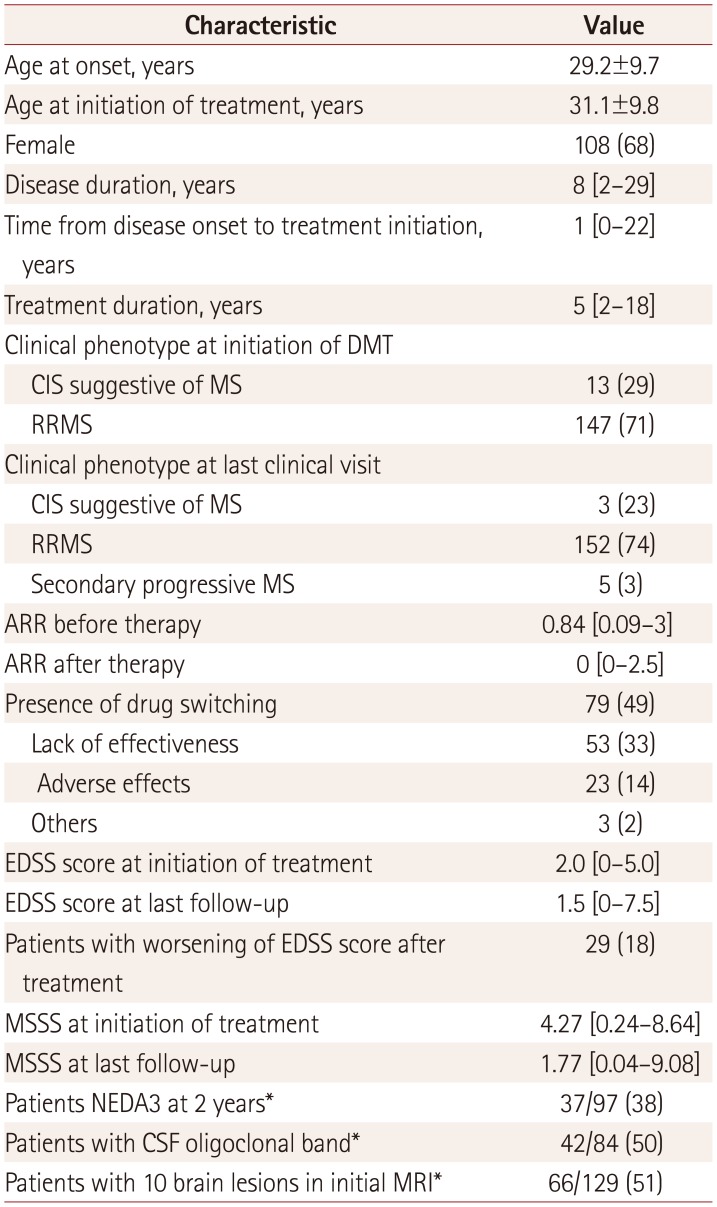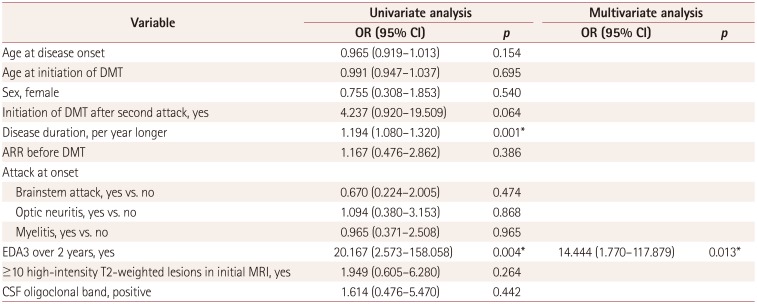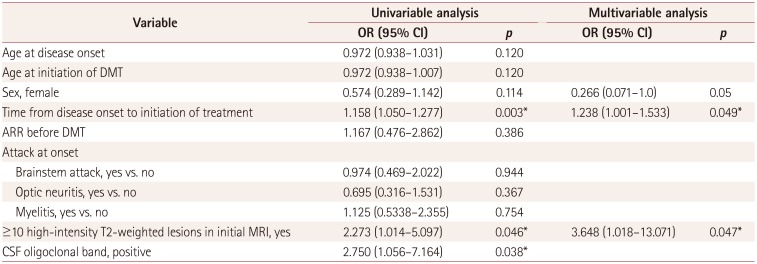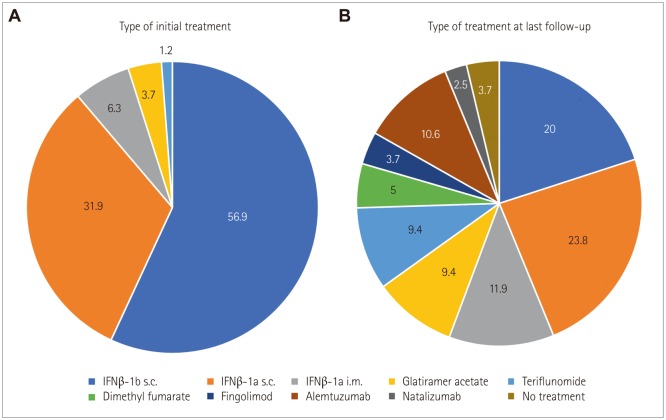1. Kappos L, Kuhle J, Multanen J, Kremenchutzky M, Verdun di Cantogno E, Cornelisse P, et al. Factors influencing long-term outcomes in relapsing-remitting multiple sclerosis: PRISMS-15. J Neurol Neurosurg Psychiatry. 2015; 86:1202–1207. PMID:
26374702.

2. University of California, San Francisco MS-EPIC Team. Cree BA, Gourraud PA, Oksenberg JR, Bevan C, et al. Long-term evolution of multiple sclerosis disability in the treatment era. Ann Neurol. 2016; 80:499–510. PMID:
27464262.
3. Jokubaitis VG, Spelman T, Kalincik T, Lorscheider J, Havrdova E, Horakova D, et al. Predictors of long-term disability accrual in relapse-onset multiple sclerosis. Ann Neurol. 2016; 80:89–100. PMID:
27145331.

4. Tintore M, Rovira À, Río J, Otero-Romero S, Arrambide G, Tur C, et al. Defining high, medium and low impact prognostic factors for developing multiple sclerosis. Brain. 2015; 138:1863–1874. PMID:
25902415.

5. Trojano M, Pellegrini F, Paolicelli D, Fuiani A, Zimatore GB, Tortorella C, et al. Real-life impact of early interferon beta therapy in relapsing multiple sclerosis. Ann Neurol. 2009; 66:513–520. PMID:
19847899.
6. Kim NH, Kim HJ, Cheong HK, Kim BJ, Lee KH, Kim EH, et al. Prevalence of multiple sclerosis in Korea. Neurology. 2010; 75:1432–1438. PMID:
20956788.

7. Polman CH, Reingold SC, Edan G, Filippi M, Hartung HP, Kappos L, et al. Diagnostic criteria for multiple sclerosis: 2005 revisions to the “McDonald Criteria”. Ann Neurol. 2005; 58:840–846. PMID:
16283615.

8. O'Riordan JI, Thompson AJ, Kingsley DP, MacManus DG, Kendall BE, Rudge P, et al. The prognostic value of brain MRI in clinically isolated syndromes of the CNS. A 10-year follow-up. Brain. 1998; 121:495–503. PMID:
9549525.
9. Roxburgh RH, Seaman SR, Masterman T, Hensiek AE, Sawcer SJ, Vukusic S, et al. Multiple Sclerosis Severity Score: using disability and disease duration to rate disease severity. Neurology. 2005; 64:1144–1151. PMID:
15824338.

10. Pachner AR, Steiner I. The multiple sclerosis severity score (MSSS) predicts disease severity over time. J Neurol Sci. 2009; 278:66–70. PMID:
19138773.

11. Confavreux C, Vukusic S, Adeleine P. Early clinical predictors and progression of irreversible disability in multiple sclerosis: an amnesic process. Brain. 2003; 126:770–782. PMID:
12615637.

12. Calabresi PA, Radue EW, Goodin D, Jeffery D, Rammohan KW, Reder AT, et al. Safety and efficacy of fingolimod in patients with relapsing-remitting multiple sclerosis (FREEDOMS II): a double-blind, randomised, placebo-controlled, phase 3 trial. Lancet Neurol. 2014; 13:545–556. PMID:
24685276.

13. Kim SH, Huh SY, Kim W, Park MS, Ahn SW, Cho JY, et al. Clinical characteristics and outcome of multiple sclerosis in Korea: does multiple sclerosis in Korea really differ from that in the Caucasian populations? Mult Scler. 2013; 19:1493–1498. PMID:
23407702.

14. Weinshenker BG, Bass B, Rice GP, Noseworthy J, Carriere W, Baskerville J, et al. The natural history of multiple sclerosis: a geographically based study. I. Clinical course and disability. Brain. 1989; 112:133–146. PMID:
2917275.
15. Piccolo L, Kumar G, Nakashima I, Misu T, Kong Y, Wakerley B, et al. Multiple sclerosis in Japan appears to be a milder disease compared to the UK. J Neurol. 2015; 262:831–836. PMID:
25605435.

16. Rotstein DL, Healy BC, Malik MT, Chitnis T, Weiner HL. Evaluation of no evidence of disease activity in a 7-year longitudinal multiple sclerosis cohort. JAMA Neurol. 2015; 72:152–158. PMID:
25531931.

17. Nixon R, Bergvall N, Tomic D, Sfikas N, Cutter G, Giovannoni G. No evidence of disease activity: indirect comparisons of oral therapies for the treatment of relapsing-remitting multiple sclerosis. Adv Ther. 2014; 31:1134–1154. PMID:
25414048.

18. Uher T, Havrdova E, Sobisek L, Krasensky J, Vaneckova M, Seidl Z, et al. Is no evidence of disease activity an achievable goal in MS patients on intramuscular interferon beta-1a treatment over long-term follow-up? Mult Scler. 2017; 23:242–252. PMID:
27230790.

19. Río J, Rovira À, Tintoré M, Otero-Romero S, Comabella M, Vidal-Jordana Á, et al. Disability progression markers over 6–12 years in interferon-β-treated multiple sclerosis patients. Mult Scler. 2018; 24:322–330. PMID:
28287331.
20. Erbayat Altay E, Fisher E, Jones SE, Hara-Cleaver C, Lee JC, Rudick RA. Reliability of classifying multiple sclerosis disease activity using magnetic resonance imaging in a multiple sclerosis clinic. JAMA Neurol. 2013; 70:338–344. PMID:
23599930.

21. Ransohoff RM, Hafler DA, Lucchinetti CF. Multiple sclerosis-a quiet revolution. Nat Rev Neurol. 2015; 11:134–142. PMID:
25686758.

22. Hupperts R, Ghazi-Visser L, Martins Silva A, Arvanitis M, Kuusisto H, Marhardt K, et al. The STAR study: a real-world, international, observational study of the safety and tolerability of, and adherence to, serum-free subcutaneous interferon β-1a in patients with relapsing multiple sclerosis. Clin Ther. 2014; 36:1946–1957. PMID:
24811754.

23. Carroll WM. Clinical trials of multiple sclerosis therapies: improvements to demonstrate long-term patient benefit. Mult Scler. 2009; 15:951–958. PMID:
19465446.

24. Freedman MS. Long-term follow-up of clinical trials of multiple sclerosis therapies. Neurology. 2011; 76:S26–S34.








 PDF
PDF ePub
ePub Citation
Citation Print
Print



 XML Download
XML Download